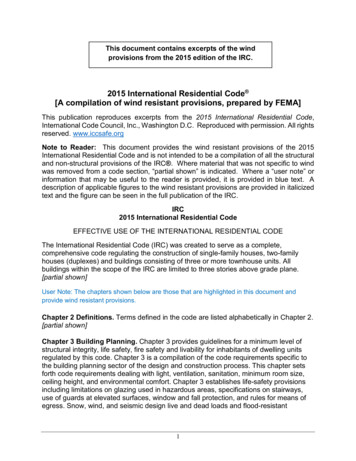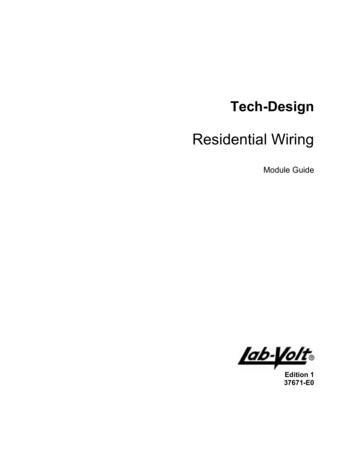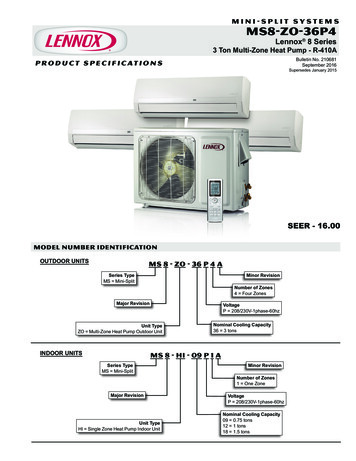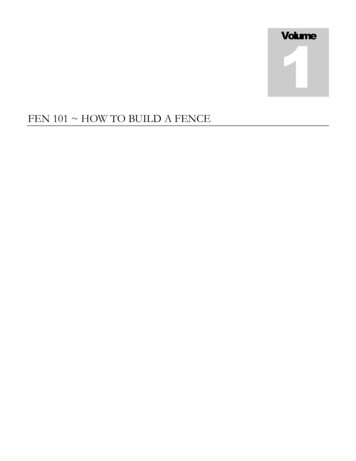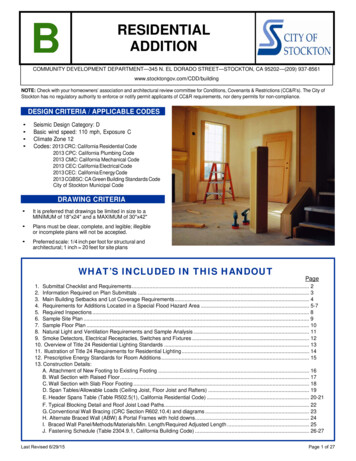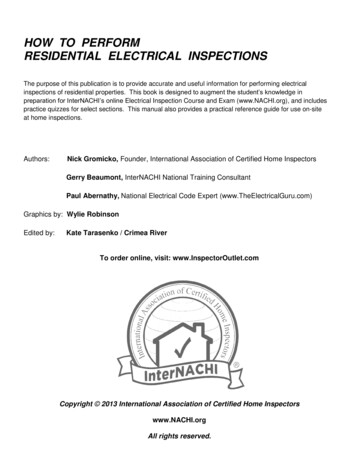
Transcription
1 HOW TO PERFORMRESIDENTIAL ELECTRICAL INSPECTIONSThe purpose of this publication is to provide accurate and useful information for performing electricalinspections of residential properties. This book is designed to augment the student’s knowledge inpreparation for InterNACHI’s online Electrical Inspection Course and Exam (www.NACHI.org), and includespractice quizzes for select sections. This manual also provides a practical reference guide for use on-siteat home inspections.Authors:Nick Gromicko, Founder, International Association of Certified Home InspectorsGerry Beaumont, InterNACHI National Training ConsultantPaul Abernathy, National Electrical Code Expert (www.TheElectricalGuru.com)Graphics by: Wylie RobinsonEdited by:Kate Tarasenko / Crimea RiverTo order online, visit: www.InspectorOutlet.comCopyright 2013 International Association of Certified Home Inspectorswww.NACHI.orgAll rights reserved.
2 This book is dedicated to the memory of Gerry Beaumont, InterNACHI’s first EducationDirector.Gerry was the author of our original residential electrical inspection course, whichevolved into our latest course on which this book is based. Gerry was instrumentalin developing the foundation of InterNACHI’s educational curriculum. He helpedcountless inspectors over the years, guiding them with his professionalism andexpertise.We are grateful that Gerry shared his light with us, and we are forever indebted tohim for spreading his wealth of knowledge and his abundant enthusiasm for life.
3 Residential Electrical InspectionIntroduction .4Safety First: Electrical Safety.4Basic Terms 5Simple Theory. 6Conductor Sizes 8Service Entrance . . 14Service Drop . 14Service Mast and Attachments . 18Service Lateral . 21Electric Meters and Bases. 23Service Entrance Cable. 25Grounding and Bonding . 32Grounding System 32Bonding of Components . 37Panels and Enclosures 38Service Panels . . . 44The Main Disconnect . . 44Service Amperage . . 47Inspecting Enclosures, Part I 49Inspecting Enclosures, Part II. 52Inspecting Enclosures, Part III . . 54Edison Base Screw Fuse Panels. 57Circuit Breaker Panels . . 60Problem Panels . . 653-Phase Panels . 72Panel Oddities 74Electrical Distribution . 79Wiring Types . . 79Aluminum Wiring . 84Branch Circuit Connections. 86Protection of Wiring . 91120-Volt Terminations . 95Testing Outlets . 99240-Volt Terminations . 109GFCI Circuits . 111Lighting Circuits 114AFCI Requirements . 118
4 INTRODUCTIONSAFETY FIRST: ELECTRICAL SAFETYElectricity KillsThe primary responsibility for a home inspector, when evaluating electrical systems in the home, is thesafety of himself and his clients, both at the time of inspection and after they move into the property.This is also one of the few areas which most home inspectors would cite as "deficient" –- systems thatwere acceptable when the home was built, but would now be considered sub-standard. A lack of GFCIs,for example, would fall into this category.Primary SafetyThe home inspector should be especially cautious when evaluating the service panels, as theseare among the few components that we remove access panels from, exposing the live componentswithin.Inspectors should follow these basic safety rules when inspecting live electrical components:Wear protective eye-wear.Wear electrician’s gloves (600-volt rated).Do NOT wear nylon or polyester clothing.Do NOT allow the client to get between the inspector and any live components.Visually inspect the panel before removing the dead front.Do NOT open a panel that is either very rusted or shows signs of moisture.Do NOT open any panel that is buzzing or arcing.Before removing the dead front, test for stray voltage with the back of the hand, or use aa voltage tic.Do NOT insert any probes or tools into the service panel.NEVER put ladders up under the service drop.If in any doubt about anyone’s safety,defer the inspection to a licensed electrical contractor.
5 BASIC TERMSUsing the Correct TerminologyOne of the challenges facing home inspectors doing the electrical portion of home inspections is gettingthe terminology right. Many home inspectors end up looking inexperienced or unprofessional by notknowing the correct verbiage. For example, a wire is more properly called a conductor.Here is a list of commonly used terms and their correct usage. Understanding these terms will help theinspector recognize improper panel wiring, especially in the case of grounded and ungroundedconductors.WHAT IT ISWHAT IT’S CALLEDhot or live wireungrounded conductorneutral wiregrounded conductorpanel earth groundgrounding electrode conductorearth or ground wireequipment grounding conductorground rodgrounding electrodemain (disconnect)service disconnectmain panelservice or distribution panel containing the servicedisconnectsub-paneldistribution panel remote from the servicedisconnectpanel coverdead frontwires to outletsbranch circuit conductorsoutletlighting and/or receptacle outletservice to remote panelfeederGetting the terminology right will prevent a lot of "Your inspector doesn't know what he'stalking about" comments from local electrical contractors.
6 SIMPLE THEORYUnderstanding How Electricity WorksElectrical supply is actually the movement of electrons flowing along a conductor in much the same wayas water flows through a pipe. The same fundamental principles apply in the same way: the bigger thepipe, the more flow it can handle. Conversely, smaller pipes can handle small supplies. This is theprinciple behind resistance.Measuring Electrical ForcesWhen discussing electrical supply, we use many different terms to quantify the amount of availablepower, the amount of work it can do, the resistance of the components and, therefore, its safe operatingparameters. Here are some easy-to-understand definitions and explanations of the terminology.Resistance: limits the conductor's ability to allow the flow of electrons, just as friction causes losses inany pipe or duct work. This is expressed in Ohms.Electromotive Force: is what drives electrons along the conductor, and is expressed as voltage orvolts.Current: is the flow of electrons driven by electromotive force through a given resistance. This isexpressed as amps.Power: is the amount of work that the electrical flow can do. This is expressed as watts or kilowatts(1,000 watts).
7 Ohms LawsGeorg Simon Ohm was a German physicist born in Erlangen,Bavaria on March 16, 1787. Ohm started his research with thethen-recently invented electric cell (invented by Italian ConteAlessandro Volta). Using equipment of his own creation, Ohmdetermined that the current that flows through a wire isproportional to its cross-sectional area, and inversely proportionalto its length. Using the results of his experiments, Ohm was ableto define the fundamental relationship between voltage, currentand resistance.These fundamental relationships are of such great importancethat they represent the true beginning of electrical circuit analysis.Unfortunately, when Ohm published his findings in 1827, his ideaswere dismissed by his colleagues. Ohm was forced to resign fromhis high school teaching position, and he lived in poverty andshame. However, his research efforts gained a lot of support outside of Germany. In 1849, Georg SimonOhm was finally recognized for his efforts by being appointed as a professor at the University of Munich.How do the Ohms Laws help us?Ohms Laws are basically a series of mathematical models that show us how to work out safe workingloads for conductors and electrical components. This allows us to understand why, for example, a 30-ampfuse should not be connected to a 14-AWG wire (that's about resistance and overheating wires).The most common Ohms Laws are:E I x R or Electromotive Force (E) equals Amps (I) multiplied by Resistance (R)or Volts equals Amps times Ohms.Simple manipulation of this equation allows one to work out any figure, given the other two components.For example, 120 volts pushed through 60 Ohms of resistance equals 2 amps.I E R or Amps (I) equals Electromotive Force (E) divided by Resistance (R).Simply put, Amps equals Volts divided by Resistance.So, a 120-volt circuit and 25 Ohms of resistance to a ground rod equals 4.8 amps.Note: This will not trip any circuit breaker.
8 CONDUCTOR SIZESUnderstanding the Limitations of ConductorsAs we saw with Ohms Law, resistance is key to a conductor's ability to safely deliver the amount of powerthat a circuit needs. Think back to the pipe: the bigger the pipe, the lower the resistance.* 14 AWG is typically rated for 15A, 12 AWG is typically rated for 20A, and 10 AWG is typically rated for30A, based on 240.4(D) of the National Electrical Code, unless otherwise permitted by 240.4 (E) or (G).Conductor MaterialWhen evaluating electrical supply, we need to recognize that copper and aluminum conductors are notthe same. Although they are both commonly used in residential supply, copper inherently has lessresistance to the flow of electrons than aluminum does.For this reason, aluminum conductors are always one to two sizes larger than the equivalent copper onefor any given amperage.Jumping ahead a bit, single-strand aluminum branch circuit wiring should always be fully evaluated by alicensed electrical contractor (multi-strand aluminum wires as seen on service entrances and highamperage circuits are not a problem). This issue is studied at greater length later in the text.
9 Conductor AmpacityAs we have seen, for larger amperages, we need larger conductors. The table below is a simple guide toamperage capacity and uses of common conductors in residential construction.Breaker/Fuse SizeCopper ConductorAluminum ConductorCommon Uses15 amp*14 AWG12 AWGlighting circuits and typicalgeneral-use receptacles20 amp*12 AWG10 AWGreceptacle circuits inkitchens, dining rooms, andvarious dedicated circuits30 amp*10 AWG8 AWGsmall AC units andclothes dryers40 amp8 AWG6 AWGstoves60 amp6 AWG4 AWGlarger (or older) AC100 amp3 AWG1 AWGremote distribution panel**100 amp based onNEC 310.15 (B)(6)4 AWG**2 AWG**SEC**150 amp based onNEC 310.15 (B)(6)1 AWG**2/0 AWG**SEC**250 amp based onNEC 310.15 (B)(6)2/0 AWG**4/0 AWG**SEC* Under limited circumstances, such as motor circuits and HVAC equipment, the amperage ratings ofthese conductors may be higher based on section 310.16 of the National Electric Code.** Services and Feeders: For individual dwelling units of one-family, two-family and multi-familydwellings, conductors, as listed in Table 310.15(B)(6), shall be permitted as 120/240-volt, 3-wire, singlephase service-entrance conductors, service-lateral conductors, and feeder conductors that serve as themain power feeder to each dwelling unit and are installed in raceway or cable with or without anequipment grounding conductor.
10 The photo at the right shows some of thecommon wire sizes for comparison (and fornewer inspectors, buying a length of eachcommon size is a great way to becomefamiliar with them).The smaller sizes are normally single-strandconductors, but as they get bigger, theyswitch to multi-strand so they can be easilyworked. It is unusual to see a conductor ofless than 8 AWG to have multiple strands.Again, we'll come back to it later, butremember to look for single-strandaluminum branch circuit wiring, especiallyin homes built between the mid-1960s andthe mid-1970s.The image at the right shows that the 14AWG is listed for 20 amps, the 12-AWG islisted for 25 amps, and the 10-AWG is listedfor 30 amps.These are the maximum allowable amperages under special circumstances, such as loads whendealing with motors and AC compressors, as well as others listed in the National Electrical Codesection 240.4(E) or (G).
11 QUIZ on INTRODUCTION1. Which of the following should NOT be worn during an inspection?safety glassesleather shoesnylon clothing2. Which of the following should be inserted into an electrical panel during an inspection?none of thesea torque wrenchan amp probea wire gauge3. The electrical panel should NOT be opened if which of the following conditions are present?any of thesemoisture dripping from the enclosurerusting enclosuresounds of arcing4. The correct name for a live wire is .a grounded conductoran ungrounded conductora grounding conductor5. An electrical panel cover is more properly called the .dead frontenclosuredistribution center6. A service panel that does not contain the disconnect is called the .main panelsub panelservice paneldistribution panel(continued)
12 7. Wires to outlets are called .receptacle cablesRomex branch circuit conductors8. Electromotive force is measured in .wattsampsvoltsohms9. Ohms are a measurement of .resistancepoweramperage10. Voltage is equal to .power x amperagewatts x currentamps x resistance11. Finish the equation: W E xOQIR12. Aluminum branch circuit conductors should be sized copper.two sizes smallerthe same asone to two sizes smallerone to two sizes larger(continued)
13 13. A 20-amp breaker should feed a minimum conductor.12-AWG8-AWG14-AWG10-AWG14. What would be the minimum service entrance cable size for a 200-amp supply?1/0 copper or 2/0 aluminum2/0 copper or 4/0 aluminum2/0 copper or 1/0 aluminum4/0 copper or 2/0 aluminumAnswer Key to Quiz on Introduction1. Which of the following should NOT be worn during an inspection?Answer: nylon clothing2. Which of the following should be inserted into an electrical panel during an inspection?Answer: none of these3. The electrical panel should NOT be opened if which of the following conditions are present?Answer: any of these4. The correct name for a live wire is an ungrounded conductor.5. An electrical panel cover is more properly called the dead front.6. A service panel that does not contain the disconnect is called the distribution panel.7. Wires to outlets are called branch circuit conductors.8. Electromotive force is measured in volts.9. Ohms are a measurement of resistance.10. Voltage is equal to amps x resistance.11. Finish the equation: W E x I12. Aluminum branch circuit conductors should be sized one to two sizes larger than copper.13. A 20-amp breaker should feed a minimum 12-AWG conductor.14. What would be the minimum service entrance cable size for a 200-amp supply?Answer: 2/0 copper or 4/0 aluminum
14 SERVICE ENTRANCESERVICE DROPOverhead ServiceIn many older residential areas, and practically all rural locations, the electrical supply is delivered to theproperty via overhead conductors strung on telegraph poles. The high-voltage lines connect directly tothe property through a transformer delivering mains power.While the service overhead belongs to the utility company, the inspector should still evaluate it,particularly to indicate the available voltage, its clearances, and any mechanical damage.The Cable AssemblyMost residential buildings are supplied with 120/240-volt services. This means that the cable assemblyis made up of two ungrounded (live or hot) conductors, each supplying 120 volts, and one neutral orgrounded conductor acting as the return.Many homeowners mistakenly believe that the three conductors are one each of a live, a neutral, and aground. In fact, to have 240 volts available in the home, we need two separately derived 120-voltungrounded conductors, and a grounded conductor. The ground does not return to the pole through thecable assembly; the grounded conductor serves the role of the return path to the transformer.There are, however, a few variations on the theme. It is not unusual to see one of the live conductorstied back. This is indicative of a 120-volt-only supply, which is still in some older properties, andapartments and condos.
15 Conversely, the inspector may see cable assemblies with more than three connected conductors. This istypically a 3-phase supply commonly found in both commercial and agricultural environments.In the case of 120-volt-only supply, we recommend that the inspector's report shows this limitation.In the case of high-voltage, 3-phase supplies, we recommend that the inspector defers this part of theelectrical inspection to a qualified industrial or commercial electrical contractor.Service Cable ConnectionsThe service cables are connected to the service entrance cables by crimpedconnectors, which are then covered in an insulated sleeve.The image at the right shows that the required insulators are missing anda very dangerous condition exists, especially to the unwary home inspector(photo courtesy of Steve Stanczyk).Attachment to the StructureAs already discussed, the neutral (grounded conductor) also servesas the main physical connection (though insulated) to the building.The inspector should ensure that this strain relief is not detached orpulling away from the structure.On some older properties, the conductors are not in an assembly,and each has its own connection to the structure, but this is rarethese days, and probably in need of replacement.The photo at the left (by David Macey) shows one of these olderconnections.
16 ClearancesAs can been seen in the first image of this section (and in the tablebelow), the overhead service must have some minimum separationfrom both the structure itself and any walkways, driveways, balconies,patios and swimming pools.Very often, an inspector will see properties that have been modified,and the service overhead should have been relocated, but wasn't.This can obviously lead to some dangerous conditions, especially overswimming pools and decks where the service connections could beaccidentally reached by the homeowner.The picture at the right shows where a second-story deck has beenadded, putting the electrical supply too close to the walking surface.In this particular case, the service cable assembly is also too close to the front of the window.LocationMinimum Clearance Requirementstreets and roadways18 feetcommercial parking lots18 feetswimming pools22 feet, 6 inches above and10 feet horizontallyover all residential areas, includingdriveways and parking lots12 feetareas with pedestrian-only access andlowest level to the drip loop10 feetflat roofs (above decks at 10 feet)8 feetpitched roofs 4:12 or above3 feetattachment to mastover roof surface18 inches(if within 4 feet of roof edge)windowsThe service cable should be no closerthan within 3 feet of the bottom,sides and front
17 Another common clearance problem is caused by trees and shrubsinterfering with the overhead supply. The inspector should take thetime to eyeball the length of the supply from the pole to theattachment point on the structure, and report any tree limbstouching the conductors.Also remember that the branches are heavier during the summerand weigh down further on the conductors. What may be marginalduring the winter months may well cause a problem later in thegrowing season.The inspector should recommend that any limbs within 5 to 6 feet ofthe cable assembly be cut back.The image at the left shows a tree viciously attacking the servicesupply (photo courtesy of Peter Siposs).
18 SERVICE MAST AND ATTACHMENTSservice mast head(4.5’ maximum between attachment points)In most cases where the home is fed by a service overhead, the supply is fed down the outside of thehouse through a conduit known as the service mast. In some cases, the cable assembly is of type-SE,which requires no conduit.MastheadThe masthead, or gooseneck, as it is sometimes called when SEcable is used, is at the top of the mast itself. Its purpose is twofold:first, to act as a rain cap to stop moisture from entering the conduit;and, second, to provide the bushings to prevent the individualconductors from being damaged by rubbing against the metalcomponents.The masthead should be undamaged and securely fastened to theservice mast.The inspector should report any loose fittings or cracks in themasthead and its clamp.In the picture above-right (by Brian Goodman), the service has beendamaged by a falling tree branch. Not only is the masthead smashed,but also the neutral conductor splice was torn apart and repaired using jumper cables!
19 Drip LoopBefore the conductors enter the service mast head, there should bea loop in the conductors. The lowest point of these loops should be12 inches below the point of entry into the masthead itself. This isto prevent rainwater from migrating along the conductors or cableassembly and pouring down into the masthead.In the picture at the left (by David Macey), it is clear that there isno loop in the conductors. In this case, it was caused by afailure of the cable assembly connection to the home.Mast SupportAny mast in excess of 5 feet high requires guy-wires to support the mastprojection. The weight of the cable assembly is considerable and, whenapplied to an overly tall mast, has the ability to bend it right over.For the same reason, the inspector should report anything other than thecable assembly being supported by the service mast.It is far from uncommon to see telephone cables, TV cables, satellite dishes,clotheslines, and supplies to remote buildings being supported by the servicemast.The inspector should report all of these as in need of repair or relocation.Service Mast FlashingsAs with any other projection through the roof surface, the servicemast should be adequately flashed to prevent water from enteringthe building.It is not unusual to see signs of water leakage through the roof dueto poor mast flashings. Because the mast is generally outside of theconditioned space, these leaks commonly go on for years, causingconsiderable damage to the roof sheathing and fascia.The picture on the left not only shows a silicon repair to the flashing(common on a re-shingled roof), but also note the complete lack ofa masthead.
20 Service Mast AttachmentIn the case of rigid conduit service masts, they should be attachedto the structure every 5 to 6 feet throughout their length, andshould also have a clamp within 12 inches of either side of themeter base, as well as at the top of the mast, if it doesn't projectthrough the roof.It is all too common to see the attachment clamps not replacedor loose after the building siding has been replaced.The picture at the right shows where a clamp has not beenre-tightened. Indeed, the clamp bolt is completely missing.Any defects in this area should be reported as in need of repairby a licensed electrical contractor.Type-SE CableThe "SE" in SE cable stands for service entrance. This cableassembly is designed with a high degree of resistance to mechanicaldamage and the sun's UV (ultraviolet) rays. For this reason, it is notinstalled in a conduit, but is attached directly to the building.However, if it is located some place where it is likely to be subject tophysical damage from car doors, etc., then it must be protected bya conduit.It should still feature a gooseneck or service-head cap, and the end where the individual conductors exitthe sheathing should be protected from moisture intrusion by a heat-shrunk sock if a gooseneck is used.This type of cable should be attached to the building every 30 inches along its length, and within a foot ofits top and any meter can.In the photo above, a clamp is missing at the top.
21 SERVICE LATERALservice lateral undergroundUnderground Service SupplyAs previously discussed, in most newer and densely populated areas, the electrical supply is fedunderground. This is properly called a service lateral.Other than during the very early stages of construction, the home inspector is not able to evaluate theconduit or cable, but, for informational purposes, there are some restrictions that apply to undergroundservices that should be noted.Direct-Burial CableType-UF cable is rated for direct burial, and has outer sheathing that isresistant to moisture and damage from soil. This type of cable must beburied to a depth of 18 to 24 inches (depending on the location, asdescribed in section/table 300.5 of the NEC) and, if embedded in rockyground, must be installed in a manner that will not damage the cable.This cable still needs to rise in a conduit to prevent mechanical damagebefore it enters the building.The image at the right shows a typical installation. Notice the cable loopwhere the cable turns up towards the home. This is to allow for anybuilding settlement. Also, the conduit features a bend at the bottom tosmooth the transition from the horizontal to the vertical.The visible conduit should be made of either galvanized steel or gray plastic, rated for the purpose.
22 Underground ConduitWhere the service entrance cable is not rated for directburial, it needs to be in a full conduit, and must be buried ata minimum depth of 18 inches under landscape, and 24inches under hardscape, such as driveways.Where the service conductors are buried underground, theyare required to have a ribbon embedded 12 inches abovethe conductor, unless they are under the exclusive control ofthe utility company.The picture at the left shows a commercial building'selectrical service.In residential construction, there would be only one conduit.Above-Ground ConnectionThe home inspector should evaluate any visible above-ground conduits and report any damage or openjoints that would allow moisture into the assembly.The images above show (left to right): a typical service lateral riser; and a damaged conduit.(Photos courtesy of Pat Dacey.)
23 ELECTRIC METERS AND BASESThe electric meter is not normally part of the service entrance equipment. It is there to measure theamount of power used on the property. Some properties may have more than one meter, maybe due tomultiple occupancy or discounted power for heating use.As the meter is a rated component like any other, the ampacity of the meter and its base cannot belower than the stated total available amperage. We will look at this further in the next section.Meter BasesAs meters have increased in capacity over the years, the meter baseshave changed. The very earliest meters (as pictured at the right) had noseparate base, and are typically rated for only 30-amp supply.Round meter bases: Common from the 1920s up to the 1950s,they were rated for only 60 amps and are still often seen on olderproperties.Square meter bases: Typically found on homes from the 1950s to1970s, these are still used in some smaller housing units, such asapartments, and were only rated for 100-125 amps.Rectangular meter bases: are the current minimum on singlefamily homes. These are rated for 200 amps and typically bear themarking "200CL."
24 Understanding meter bases is an important part of being able to properly evaluate the maximumavailable amperage in the home, but should not be relied on completely when sizing a service.Typical Meter InstallationsPictured above (left to right): multiple 60-amp round meter bases on a quadplex;100-amp square meter base; and a modern 200-amp rectangular meter base.Pictured above (left to right): a 100-amp combination panel next to an older 60-amp meter;a dual meter panel for a property that has off-peak electric heat; and a modern 400-ampsupply split between 2 x 200-amp breakers. (Photos courtesy of Bruce King.)
25 SERVICE ENTRANCE CABLENOTE: For simplicity’s sake, not all components are pictured here.SECsThe service entrance cable (SEC) is the conductor assembly that connects from the service supply,through the meter socket, and on to the primary service disconnecting means.Obviously, the conductors are another rated component, and the home inspector needs to be familiarwith the current-carrying capacity of the various sizes of cables.Conductor MaterialsService entrance conductors, like all others, are made from either copper or aluminum. As discussedpreviously, aluminum conductors need to be sized larger than copper ones for any given amperage.Aluminum terminations may also be coated with an antioxidant to prevent corrosion, although the morerecent AA-8000 aluminum alloy conductors do not require it.The use of copper is most common, since it is the default conductor by code, but aluminum is popular forservices when cost is an issue.
26 Service Entrance Conductor AmpacityThe table below shows the common cable sizes for both copper and aluminum, together with theirampacity and wire size.Service AmperageSolid WireDiameter inInchesCopperConductorAluminumConductor30 amps0.10210 AWG8 AWG60 amps0.1626 AWG4 AWG100 amps*0.2044 AWG2 AWG110 amps*0.2293 AWG1 AWG125 amps*0.2582 AWG1/0 AWG150 amps*0.2891 AWG2/0 AWG175 amps*0.3251/0 AWG3/0 AWG200 amps*0.3652/0 AWG4/0 AWG225 amps*0.4103/0 AWG250 kcmil250 amps*0.4604/0 AWG300 kcmil300 amps*0.500250 kcmil350 kcmil350 amps*0.592350 kcmil500 kcmil400 amps*0.632400 kcmil600 kcmil
27 NOTE:Increasing gauge numbers provides decreasing wire diameters. For example, when the diameter of a wireis doubled, the AWG decreases by 6. The AWG sizes are for single, solid, round conductors. The AWG ofa stranded wire is determined by the total cross-sectional area of the conductor, which determines thecurrent-carrying capacity and electrical resistance. The stranded wire is about 5% larger in overalldiameter than a solid wire of the same AWG.* 100-amp to 400-amp
This book is dedicated to the memory of Gerry Beaumont, InterNACHI’s first Education Director. Gerry was the author of our original residential electrical inspection course, which evolved into our latest course on which this book is based. Gerry was instrumental in developing the fou
